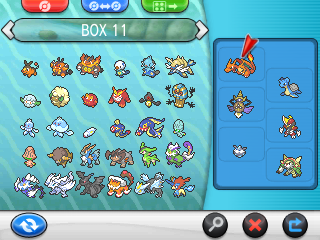
"Strong Pokémon. Weak Pokémon. That is only the selfish perception of people. Truly skilled trainers should try to win with their favourites."
In the past few months, we have dealt with the core mechanics of Pokémon, from EV training to IV breeding, and now comes the most unique part of Pokémon, the building of the team. Especially ahead of the Video Game Championship events coming up in May and beyond.
Subscribe to Nintendo Life on YouTube841k
This sort of thing is one of the most subjective things about Pokémon as there is such variety with not only Pokémon species, but with how to use each individual Pokémon in the various battles.
I'm not going to tell you what Pokémon to use, as that would result in people having the same team and that's not fun at all. I will, however, be giving you the details to help you make a decision on how to start building a team. It's not going to go crazily into every intricate detail of competitive team building, but it's going to give you a decent start.

Rules
To start with, we'll deal with the rules that are part of the game. While many online communities set their own rules, restricting Pokémon to specific tiers, the actual game only has a small amount of rules for you to select when starting with a battle.
First, let's just do a quick rundown of the types of battle. First are Single Battles, where you use 1 Pokémon at a time, then Doubles where you use 2 at a time, Triples where you use 3 at a time, and Rotation where you send out 3 at once, but only use one, rotating between the three as you see fit in the turn.
Into the rules, there are three official rulesets accessible by yourself in the game. First are No Restrictions, which means that you can use any Pokémon you want, at any level, with no restrictions to items or repeating the Pokémon.
Next is the Normal Battle Mode. This mode is like No Restrictions, but it makes all of your Pokémon Level 50 as standard rather than having the levels range. This is a good mode for battles as it puts all Pokémon on a level playing field despite how far advance they are.
Finally are Flat Rules. These Rules are the ones you see in Random Matchup, Battle Maison and various online competitions. They are a bit complex, so this table will help illustrate it:
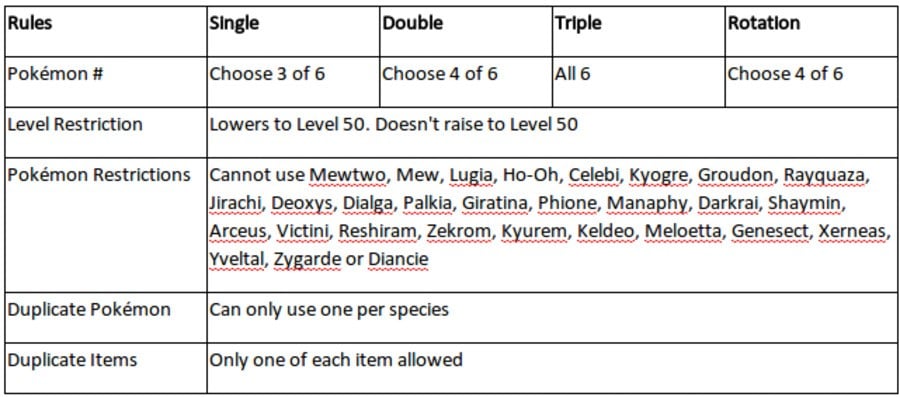
There are also variations to the above rules that you will see from time to time. For example, Japan once had a competition where you could only use Eevee Evolutions, another that was Kanto Dex only.
The upcoming Video Game Championships use a modified variation of the Double Battle Flat Rules, including clauses that mean you can only use Pokémon that were caught or hatched in Pokémon X & Y and Pokémon only in the three Kalos Regional Pokédexes. This means you can certainly experience variety within these games.
Choosing Pokémon & Moves
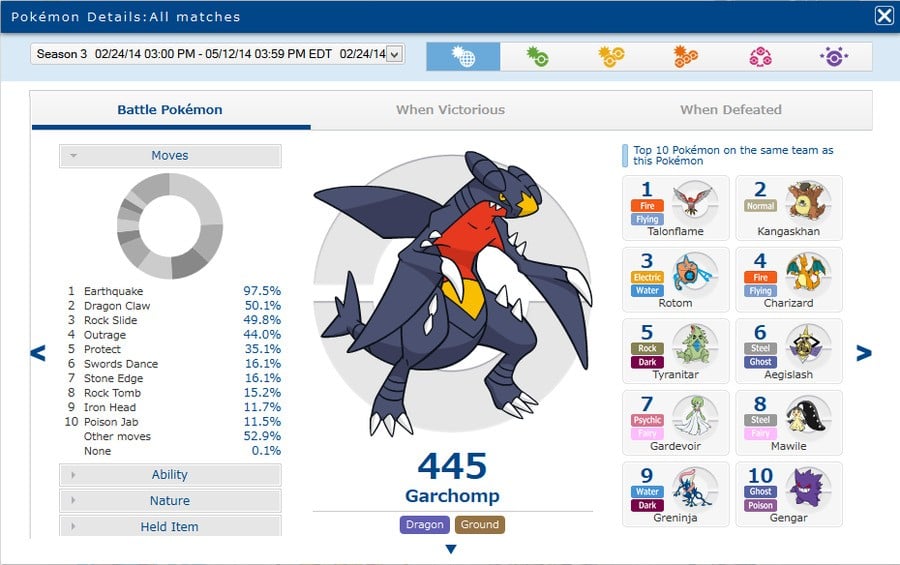
This is where things get complicated. There are 719 confirmed Pokémon available in the game, several with countless forms and 28 with available Mega Evolutions which means possibilities are endless.
So, what Pokémon should you use? That's totally up to you. Obviously, if you're going to go for competitive battling, you won't be using ones such as Sunkern, which narrows the range down somewhat.
The best thing to do is first to choose one Pokémon you wish to use. Typically, this means you can build a team around that, filling in gaps where they may exist. However, you need to consider more than just species. If you're using a Pokémon like Tyranitar, it's likely to have its ability of Sand Stream which creates a Sandstorm which damages all Pokémon that aren't Ground, Rock or Steel-types. As such, putting in a Pokémon such as Shedinja would be suicide as you'd end up killing it.
If you're in Doubles & Triples, you need to think strategically as well. If you're going to use Earthquake on a Pokémon, then you should team it with a Flying-type Pokémon or one with the ability Levitate so that they won't get hit by your own move.
As each Pokémon has got varied stats, you're going to want to give them a moveset that monopolises upon its strength. If you're using a Talonflame, for example, you're going to want to focus its moves on physical due to its high Attack stat being much larger than its Special Attack.
You'll also want to make sure the movepool is diverse. If you set up a Blastoise and give it only Water-type offensive moves, you're going to have a bad time. The key to Pokémon is to try and surprise people with moves that they may not expect.
Due to the variations in stats & movepools, many terms have been coined to describe various Pokémon. There's a rather large amount so I'm only going to cover the basics
- Leads are of course the Pokémon you start with. Typically they are used to set things up such as entry hazards or to inflict some surprising damage.
- Sweepers are ones where they have decent moves that can do considerable damage. These are subcategorised into three categories: Physical, Special and Mixed Sweepers.
- Bulky Pokémon are ones which have got significant defences and Hit Points so they can survive hits.
- Glass Cannons are Pokémon that can hit very hard, but will likely go down with a single hit due to frail defences.
- Tanks are Pokémon that have decent defences and moves that can do significant damage. These Pokémon are always a pain for people to take out.
- Supporters are Pokémon that seldom actually attack themselves, but have a variety of non-attacking moves that can help benefit your team such as recovery or stat alteration.
Obviously, you're going to want to mix these roles into your team accordingly so that you're not just left with a team of sweepers. You need to think about getting decent coverage and preparing for what could easily take down your Pokémon.
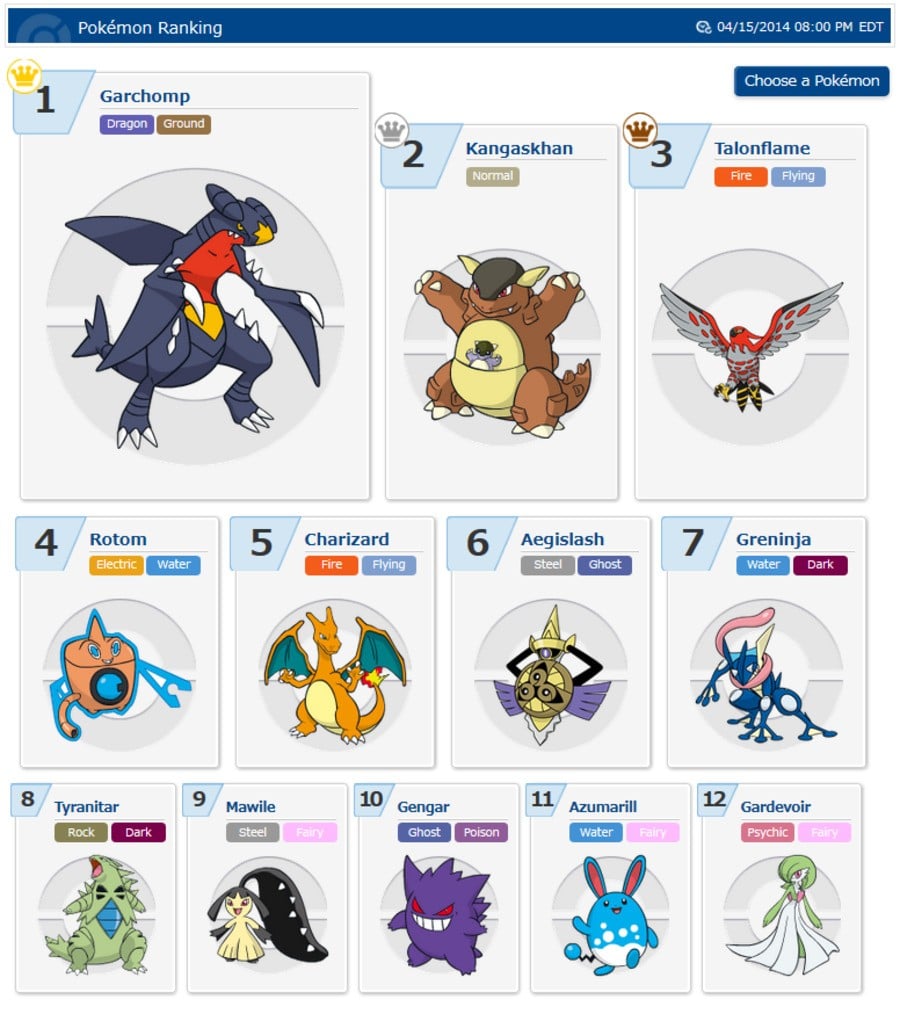
Now, I imagine that, to the more casual player or one who is just starting to get into competitive, this is incredibly daunting. Thankfully, there are resources around the Internet that can help you. Sites like my own Serebii.net and Smogon provide various moveset recommendations for Pokémon, along with the best way to use them and who to partner with them, but the best resource has come to be the Pokémon Global Link.
With X & Y, the Global Link has added some amazing features. Under the Rating Battle section, you have the ability to check the stats for various Pokémon. This section compiles everything you could possibly imagine about all Pokémon that have been used in the Rating Battle mode for all battle types. It lists the top 10 moves, items, the top abilities for each Pokémon. It also lists what Pokémon are commonly used to partner with it and, even better, shows the most common Pokémon that are used to defeat it.
Such a feature is very handy for a budding trainer as you'll be able to easily see what works on a Pokémon and what doesn't, just by browsing the Global Link. Just remember, try to be imaginative. Many teams have had the best stuff and failed while the underdog with an awesome unseen strategy has prevailed.
Strategies that work well together are key. In Single Battles, switching is often used to try and get an advantage. In Doubles & Triples, the Pokémon should work well together such as the aforementioned Earthquake thoughts or strategies such as using your own moves to power up a team-mate.
You also need to think about how to use your opponent's team to your advantage. Like any team, they are going to have holes and weaknesses. Obviously, you can't plan for every single contingency, but using your strengths and your opponent's weaknesses on the fly is a very handy thing to do.
For example, check this battle video in your VS. Recorder to see how you can set up something to get your Pokémon to shine: DEQG-WWWW-WWW5-YWJ2. In this battle, I used an entry hazard to my advantage, and then monopolised on my opponent's ability while fully abusing my own Pokémon's ability. These sort of strategies are ones you need to think about rather than just going for force.
Think carefully and check the resources at your disposal, but most of all, try to be unique.
Testing the team
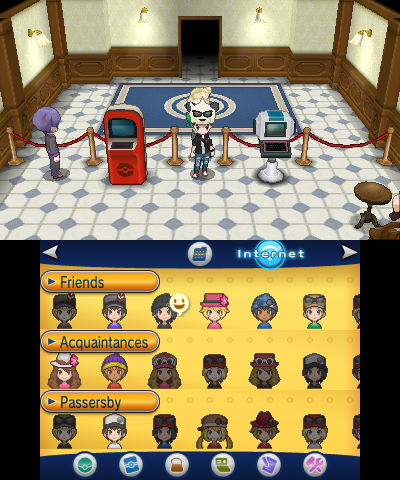
OK, so you've worked out a team, you've bred and trained it so you're ready to go. Though, so many ideas are great on paper, but may not work out in reality due to a variety of factors, so you'll want to test the team. While you can test your team against friends, that may not be the best way to go about it as they'd know you. Thankfully, there are other options.
Most notably, in Lumiose City is a Battle Institute building. Here, you can test your team using the standard Flat Rules against 5 different trainers of varying and increasing difficulty. These trainers start off easy, but become hard as nails. Once you have completed it, you will get ranked based on your performance. This takes the amount of Pokémon you have lost, amount of Super Effective hits you got, amount of times you were hit by non-effective moves etc. and gives you a point rating and ranking based on it. Of course you will want a high rating if your team has done well. Even if not, this isn't a waste of time as you will receive Battle Points! You can also test it in the Battle Maison and see how far you can get.
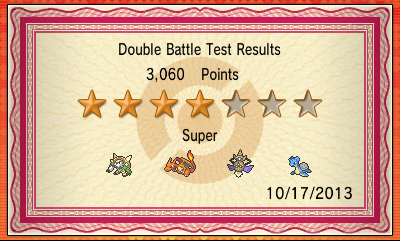
Another way of testing it is to go onto Free Battle & Rating Battles itself in the Battle Spot mode of the game. This will match you up with random trainers who follow the same rules. There are a few drawbacks to this, however. Free Battle is a fine mode, but has no restrictions so you may not get the true experience as you will undoubtedly face many legendary Pokémon while with Rating Battles, your score with wins and losses is recorded meaning that if you don't do well, it will affect your position in this season of the battles.
If you're happy after all the testing, then your team is good to go for competitions or to destroy your friends!





Comments 36
This was a great article/guide! It's very informative and puts many details in an informative and easy-to-read manner. I've played all of the Pokemon games, but have only recently considered getting into competitive. This should help a lot.
Ahhhh... Pokemon battling and training... it used to be so much fun when I was younger. For some reason... I found it annoying in X/Y.
freaking Garchomps must be eliminated.
Garchomps, destroying my teams since 2007
My favourite Pokémon is Galvantula, and unfortunately, he isn't exactly the strongest out there. I have a team of Heat Rotom, Weavile, Ludicolo and Gliscor that I think work pretty well, but I'm not completely serious about the competitive side of things, so they're probably not going to do well in a real tournament. I also refuse to use Pokémon I dislike... Garchomp is one of my least favourites!
Thanks for the guide! Sites like Smogon are great, but can really get confusing if you just jump into a pokemon page and have no idea what any of it means I've been EV training a competitive team, though am not sure which Pokemon to pick for my main team as I narrowed it down to 8 Pokemon so far. This helped me decide how to weed through them though :3 thanks again!
Nice job on the article @Serebii, you really explained this well for newcomers. :3
My only suggestion for trainers would be to use Pokemon Showdown, as it lets you test things...before having to breed, in live battles. It is an invaluable tool that I'm sure you know about of course, I just want to link it in case anyone wants to try it.
http://play.pokemonshowdown.com/
Nice article I wish I had time to properly train my teams these days but at the moment I can only play casually maybe in the summer I'll have time.
Those sites are great for getting tips, and finding battles, but not for finding smart conversations,but easy to make mad
The best team you can make is one that's' full of creativity! Not a team of copy and paste, it would just be boring.
MINDBLOW! That was just what I needed to hear! I'm emailing this to myself so I can read it again later. POKEMON TIME!
Another interesting read; even though I already knew most of this, it was nice to see all this info summarized so nicely. One thing I noticed is that there was no mention of items anywhere; the choice of held item is really important in competitive battling.
@LordJumpMad
I couldn't agree more.
I made some poor mistakes for the Pokemon Battle Tournament, but in a way I'm glad I did. It means I will be much better for it for the Nationals!
@LordJumpMad right on! though my style is to use whatever team I feel like using regardless of trends, not popular and not unpopular at the same time.
Been there, done that. I entered the Pokemon championships like 2 weeks ago, I prepped like a month in advance, but I didn't get very far, it was just bad luck though
Edit: for anyone intersested,
Azumarril
Garchomp
Venasaur
Charizard-Y
I know one thing when I played competitively back in Gen 4 I bread some of the strongest Feraligatr's around. Took down A LOT of teams during that time. I loved playing online and ppl rage quitting when id take down a legendary or id run across a team that was totally hacked (Pokemon that had an ability that it wasn't supposed to have etc.)
Great article Joe! I didn't realise or forgot there was a Battle Institute.
Great tips, I love X&Y!
Although I'm deep in the competitive scene, this is a great guide for beginners. Serebii is one of my choice sites for Pokemon, so this was a treat.
I'm not super interested in entering tournaments or anything, but I would love to be able to do better in rating battles. I think I've been improving, though, and this guide might help a little. My team has Greninja, Charizard, and Goodra, who are staying no matter what. My Greninja and especially Charizard are good move wise, but I'm still constantly trying new things with Goodra but I can't quite figure out what I want. The rest of my team (Currently Golem, Ampharos and Gardevoir) I'm still occasionally switching out and trying other pokemon with. Right now I'm wondering if I should have a Golem or Aggron, and I don't like Gardevoir that much, but her fairy/psychic type fills the gap. I also just discovered rotation battles, which seem really cool to me, so I need to try those online sometime.
Edit: Wait, Mawhile is steel/fairy? SOLD! I really like Mawhile, so that should be a good replacement for Gardevoir.
I'm surprised Gardevoir is number 12 in the rankings there, considering Mega Gardevoir is considered below OU in general.
That said I never take Gardevoir off my team myself (favorite Pokemon), I'm surprised it's become so popular with others that they are even willing to bring it into battle.
Give Gardevoir Quiver Dance already Game Freak...
The articles you've posted are informative and they're really helpful. I enjoy battling in a competitive way although I still have a lot to learn and try.
BUT I seriously disagree with guides that tell people what moves, EVs and items they should use, I believe it kills the strategy factor that make this game so awesome.
Cool! Amazing!
I can't wait to Breed for my Wi-Fi Team!
Thank you SO much Serebii and Nintendo Life for making this article!
WAY better than Smo-GONE!
Quoting Karen to open an article like this is pure win.
Everytime I battle online for Points, I get Japanese rivals...... Tried like 20 times, and 0 Wins....... ........ ....... 0_o
@BassLostie
Statistically most of the people who purchased X/Y in Japan were college students and up, so the chances are when you fight someone form Japan you're fighting someone who is competent, and from my experience, often have "perfect" Pokemon, it's not like they hide it with their all shiny Pokemon teams (not all of them, but it's pretty common).
@Jahir Glad you've liked the articles.
This one was actually the hardest I've had to write because it's so subjective, so I made sure to stay away from telling people what to use. I too hate telling people what to use. Always feel teams should represent the person and their ideas, but I cover that on my site because it's expected.
@AlexSora89 It's a quote that has always resonated with me for Pokémon training
Great guide! I'll definitely be putting this to good use as I've just gotten my feet wet in the world of battling in Pokémon Y. Thanks!
My son and I both recently picked up Pokemon X & Y. I have played the original many many years ago w/ Blue and then again very very briefly with Heartgold, so we're behind quite a bit. I was about to post the question of team building in the forums and then I saw this guide. THANK YOU!
Unfortunately, most of my first team perished in the Great SD Transfer Disaster of '14. Only Grassmash the Chesnaught and Dreadscalibr the Aegislash survived. I can only hope the spirits of Leonardo (Blastoise), T-Rox (Tyrantrum), Psychat (Meowstic), and Anubis (Lucario) guide their successors to glory. I'm so sorry my friends! :,(
@Blast Because you didn't think about stuff like this?
Can anyone explain why Talonflame is such a popular choice?
@EarthboundBenjy Have you tried using a Galvantula with Thunder? It gets 100% accuracy with Compound Eyes.
@TulipWaltz I don't know how popular the strategy might be, but a Talonflame with Gale Wings does have the odd quirk of being able to spam Fly without retaliation against a faster opponent that doesn't have any priority moves. Whether or not you go for it, Gale Wings also gives priority to Brave Bird and Roost, and along with the always powerful Flare Blitz and the ability to focus its stats on attack power without losing much in speed, it can be quite a tough opponent.
This was GREAT guide!! I should have read this before entering that April Friendly Tournament for X & Y.
@BulbasaurusRex
Yep, sure have. It's not quite 100% accuracy, but it's pretty close.
Galvantula's problem is that he's just too squishy. Even with a reliable Thunder, he's not really going to be able to take too many opponents down before something faints him in one hit.
With X and Y, Galvantula's acquired an interesting new niche in the brand new move Sticky Web, so maybe something positive might come out of that.
I beat the Elite Four pretty easily.
Talonflame- 60 Tyrantrum- 66
Vaporeon- 64 Yveltal- 61
Venesaur- 64
Trevanant- 53 (Meat Shield)
Pretty easy when you just use all your money to buy revives and max heals.
I recommend using any thing that works for you. It may sound crazy, but MAKE IT WORK. I have a Krookodile on my team. You rarely see them. But with his Moxie plus his rock slide and earthquake, he has +3 attack after 1 move. I also have a Jellicent, who a highly recommend because he takes out all of the top ranking Pokemon in the current international champions, especially Landorus and Talonflame. I also LOVE using life orbed absol (Shiny, obviously). Let him set up one swords dance and He bosses! I OHKO-ed a Mega Salamence with one no-crit slash off my +2 attack Absol, without any IVs or EV training. Just use whatever crazy stuff you have and make it work!
Show Comments
Leave A Comment
Hold on there, you need to login to post a comment...